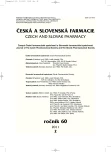Analytical evaluation of mono[{3-[4-(2-etoxyetoxy)-benzoyloxy]-2-hydroxypropyl}-isopropyl-ammonium]fumarate
Authors:
Ivan Malík 1; Fils Andriamainty 1; Eva Sedlárová 1; Jozef Čižmárik 1; Jana Gališinová 1; Petr Mokrý 2; Jozef Csöllei 2; Janka Karlovská 3; Miloš Lukáč 4
Authors‘ workplace:
Univerzita Komenského v Bratislave, Farmaceutická fakulta, Katedra farmaceutickej chémie
1; Veterinární a farmaceutická univerzita v Brně, Farmaceutická fakulta, Ústav chemických léčiv
2; Univerzita Komenského v Bratislave, Farmaceutická fakulta, Laboratórium NMR
3; Univerzita Komenského v Bratislave, Farmaceutická fakulta, Katedra chemickej teórie liečiv
4
Published in:
Čes. slov. Farm., 2011; 60, 84-93
Category:
Original Articles
Overview
The present paper deals with a complex spectral and physicochemical evaluation of mono[{3-[4--(2-etoxyetoxy)-benzoyloxy]-2-hydroxypropyl}-isopropylammonium]fumarate, a potential ultrashort acting ß1-blocker. The identity of the substance under study (labelled as UPB-1) was confirmed by 1H - and 13C-NMR spectra as well as IR spectrometry. The determined fundamental physicochemical characteristics included the determination of the melting point, solubility in a spectrum of solvents, verification of purity (adsorption thin-layer chromatography), determination of surface activity (Traube’s stalagmometric method), acidobasic characteristics (pKa value by means of alkalimetric titration), determination of log ε values using spectrophotometry in UV/VIS region, as well as the evaluation of the effect of acid and basic media on the stability of the substance under the study. Other experimentally determined parameters were lipohydrophilic characteristics essayed by means of RP-HPLC (log k’), and the shake-flask method was employed to determine the values of the partition coefficients Pexp (resp. log Pexp) in different lipohydrophilic media. On the basis of log Pexp- data, the ability of the substance to penetrate the hematoencephalic barrier was predicted. To determine the UPB-1 content, RP-HPLC (reversed-phase HPLC) method of the internal standard and UV/VIS spectrophotometry at the wavelength of 260 nm (aqueous medium) and 258 nm (methanol medium) were used.
Key words:
ß1-blockers – analytic evaluation – spectral and physicochemical characteristic – content determinbation
Sources
1. Yamakage, M., Iwasaki, S., Jeong, S.-W., Satoh, J.-I., Namiki, A.: Beta-1 selective adrenergic antagonist landiolol and esmolol can be safely used in patients with airway hyperreactivity. Heart and Lung 2009; 38, 48–55.
2. Bekker, A., Sorour, K., Miller, S.: The use of cardioselective ß-blockers in a patient with idiopathic hypertrophic subaortic stenosis and chronic obstructive pulmonary disease. J. Clin. Anesth. 2002; 14, 589–591.
3. Jindal, D., Coumar, M. S., Nandakumar, K., Bodhankar, S. L., Purohit, P. G., Mahadik, K. R., Bruni, G., Collavoli, E., Massarelli, P.: Synthesis, ß‑adrenergic blocking activity and ß-receptor binding affinities of 1-substituted-3-(2-isopropyl-5-methyl-phenoxy)-propan-2-ol oxalates. Farmaco 2003; 58, 557–562.
4. Kitamura, A., Sakamoto, A., Inoue, T., Ogawa, R.: Efficacy of an ultrashort-acting ß-adrenoceptor blocker (ONO-1101) in attenuating cardiovascular responses to endotracheal intubation. Eur. J. Clin. Pharmacol. 1997; 51, 467–471.
5. Gray, R. J.: Managing critically ill patients with esmolol. An ultra short-acting beta-adrenergic blocker. Chest 1988; 93, 398–403.
6. Atarashi, H., Kuruma, A., Yashima, M., Saitoh, H., Ino, T., Endoh, Y., Hayakawa, H.: Pharmacokinetics of landiolol hydrochloride, a new ultra-short-acting beta-blocker, in patients with cardiac arrhythmias. Clin. Pharmacol. Ther. 2000; 68, 143–150.
7. Achari, R., Hulse, J. D., Drissel, D., Matier, W. L.: Pharmacokinetics of flestolol in man: preliminary data. Br. J. clin. Pharmac. 1985; 20, 691–694.
8. Malík, I., Sedlárová, E., Čižmárik, J., Andriamainty, F., Csöllei, J.: Štúdium fyzikálno-chemických vlastností derivátov kyseliny 4-alkoxyfenylkarbámovej s bázickou časťou tvorenou substituovaným N-fenylpiperazínom. Farm. Obzor 2005; 74, 211–215.
9. Slovenský liekopis, zväzok 1. 1. vyd. Bratislava: Herba 1997; s. 22.
10. Malík, I., Sedlárová, E., Csöllei, J.: Analytické hodnotenie 1-(dipropylamino-3-piperidino-propán-1-yl)--3-pentyloxyfenylkarbamátu (CK-3635). Čes. a Slov. Farm. 2004; 53, 256–260.
11. Databáza ZirChrom: Dissociation constants of organic acids and bases. http://www.zirchrom.com/organic.htm (29.11.2010)
12. Databáza chemicalland21.com: p-Hydroxybenzoic acid. http://www.chemicalland21.com/lifescience/phar/p-HYDROXYBENZOIC%20ACID.htm (29.11.2010)
13. UNEP Publications: 4-Hydroxybenzoic acid. CAS No: 99-96-7. http://www.inchem.org/documents/sids/sids/99967. pdf (29.11.2010)
14. Fu, X.-Ch., Chen, Ch.-X., Liang, W.-Q., Yu, Q.-S.: Predicting blood-brain barrier penetration of drugs by polar molecular surface area and molecular volume. Acta Pharmacol. Sin. 2001; 22, 663–668.
15. Tsai, R.-S., El Tayar, N., Carrupt, P.-A., Testa, B.: Physicochemical properties and transport behaviour of piribedil: Considerations on its membrane-crossing potential. Int. J. Pharm. 1992; 80, 39–49.
16. Young, R. C., Mitchell, R. C., Brown, T. H., Ganellin, C. R., Griffiths, R., Jones, M., Rana, K. K., Saunders, D., Smith, L. R., Sore, N. E., Wilks, T. J.: Development of a new physicochemical model for brain penetration and its application to the design of centrally acting H2 receptor histamine antagonists. J. Med. Chem. 1988; 31, 656–671.
17. Kaliszan, R., Markuszewski, M.: Brain/blood distribution described by a combination of partition coefficient and molecular mass. Int. J. Pharm. 1996; 145, 9–16.
18. Kelder, J., Grootenhuis, P. D. J., Bayada, D. M., Delbressine, L. P. C., Ploemen, J.-P.: Polar molecular surface as dominating determinant for oral absorption and brain penetration of drugs. Pharm. Res. 1999; 16, 1514–1519.
19. Clark, D. E.: Rapid calculation of polar molecular surface area and its application to the prediction of transport phenomena. 2. Prediction of blood-brain barrier penetration. J. Pharm. Sci. 1999; 88, 815–821.
20. Pan, D., Iyer, M., Liu, J.: Constructing optimum blood barrier QSAR models using a combination of 4D--molecular similarity measures and cluster analysis. J. Chem. Inf. Comput. Sci. 2004; 44, 2083–2098.
21. Abraham, M. H., Weathersby, P. K.: Hydrogen bonding. 30. Solubility of gases and vapors in biological liquids and tissues. J. Pharm. Sci. 1994; 83, 1450–1456.
22. Feher, M., Sourial, E., Schmidt, J. M.: A simple model for the prediction of blood-brain partitioning. Int. J. Pharm. 2000; 201, 239–247.
23. West, S.D., Mowrey, D. H.: Characterization of reversed-phase HPLC solvent selectivity for the prediction of adjusted retention indices and resolution. J. Chromatogr. Sci. 1991; 29, 497–502.
Labels
Pharmacy Clinical pharmacologyArticle was published in
Czech and Slovak Pharmacy

2011 Issue 2
Most read in this issue
- Generic substitution, replacement and substitution of drugs: contemporary extent
- Myasthenia gravis – current treatment standards and emerging drugs
- Bacteriocins produced by lactic acid bacteria
- Pelletization of melts and liquids
